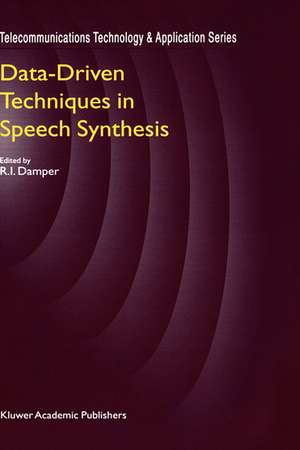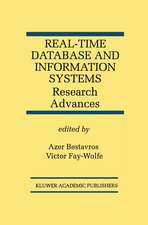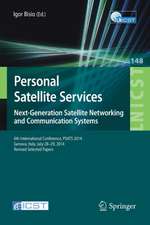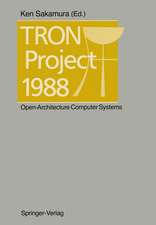Data-Driven Techniques in Speech Synthesis: Telecommunications Technology & Applications Series
Editat de R. I. Damperen Limba Engleză Hardback – 31 oct 2001
Fuelled by cheap computer processing and memory, the fields of machine learning in particular and artificial intelligence in general are increasingly exploiting approaches in which large databases act as implicit knowledge sources, rather than explicit rules manually written by experts. Speech synthesis is one application area where the new approach is proving powerfully effective, the reliance upon fragile specialist knowledge having hindered its development in the past. This book provides the first review of the new topic, with contributions from leading international experts.
Data-Driven Techniques in Speech Synthesis is at the leading edge of current research, written by well respected experts in the field. The text is concise and accessible, and guides the reader through the new technology. The book will primarily appeal to research engineers and scientists working in the area of speech synthesis. However, it will also be of interest to speech scientists and phoneticians as well as managers and project leaders in the telecommunications industry who need an appreciation of the capabilities and potential of modern speech synthesis technology.
| Toate formatele și edițiile | Preț | Express |
|---|---|---|
| Paperback (1) | 946.41 lei 6-8 săpt. | |
| Springer Us – 3 dec 2010 | 946.41 lei 6-8 săpt. | |
| Hardback (1) | 952.89 lei 6-8 săpt. | |
| Springer Us – 31 oct 2001 | 952.89 lei 6-8 săpt. |
Preț: 952.89 lei
Preț vechi: 1162.06 lei
-18% Nou
Puncte Express: 1429
Preț estimativ în valută:
182.33€ • 190.88$ • 150.87£
182.33€ • 190.88$ • 150.87£
Carte tipărită la comandă
Livrare economică 05-19 aprilie
Preluare comenzi: 021 569.72.76
Specificații
ISBN-13: 9780412817502
ISBN-10: 0412817500
Pagini: 316
Ilustrații: XVIII, 316 p.
Dimensiuni: 155 x 235 x 24 mm
Greutate: 0.66 kg
Ediția:2001
Editura: Springer Us
Colecția Springer
Seria Telecommunications Technology & Applications Series
Locul publicării:New York, NY, United States
ISBN-10: 0412817500
Pagini: 316
Ilustrații: XVIII, 316 p.
Dimensiuni: 155 x 235 x 24 mm
Greutate: 0.66 kg
Ediția:2001
Editura: Springer Us
Colecția Springer
Seria Telecommunications Technology & Applications Series
Locul publicării:New York, NY, United States
Public țintă
ResearchCuprins
1 Learning About Speech from Data: Beyond NETtalk.- 1.1 Introduction.- 1.2 Architecture of a TTS System.- 1.3 Automatic Pronunciation Generation.- 1.4 Prosody.- 1.5 The Synthesis Module.- 1.6 Conclusion.- 2 Constructing High-Accuracy Letter-to-Phoneme Rules with Machine Learning.- 2.1 Introduction.- 2.2 The Nettalk Approach.- 2.3 High-Performance ML Approach.- 2.4 Evaluation of Pronunciations.- 2.5 Conclusions.- 3 Analogy, the Corpus and Pronunciation.- 3.1 Introduction.- 3.2 Why Adopt a Psychological Approach?.- 3.3 The Corpus as a Resource.- 3.4 The Sullivan and Damper Model.- 3.5 Parallels with Optimality Theory.- 3.6 Implementation.- 3.7 Corpora.- 3.8 Performance Evaluation.- 3.9 Future Challenges.- 4 A Hierarchical Lexical Representation for Pronunciation Generation.- 4.1 Introduction.- 4.2 Previous Work.- 4.3 Hierarchical Lexical Representation.- 4.4 Generation Algorithm.- 4.5 Evaluation Criteria.- 4.6 Results on Letter-to-Sound Generation.- 4.7 Error Analyses.- 4.8 Evaluating the Hierarchical Representation.- 4.9 Discussions and Future Work.- 5 English Letter-Phoneme Conversion by Stochastic Transducers.- 5.1 Introduction.- 5.2 Modelling Transduction.- 5.3 Stochastic Finite-State Transducers.- 5.4 Inference of Letter-Phoneme Correspondences.- 5.5 Translation.- 5.6 Results.- 5.7 Conclusions.- 6 Selection of Multiphone Synthesis Units and Grapheme-to-Phoneme Transcription using Variable-Length Modeling of Strings.- 6.1 Introduction.- 6.2 Multigram Model.- 6.3 Multiphone Units for Speech Synthesis.- 6.4 Learning Letter-to-Sound Correspondences.- 6.5 General Discussion and Perspectives.- 7 TreeTalk: Memory-Based Word Phonemisation.- 7.1 Introduction.- 7.2 Memory-Based Phonemisation.- 7.3 tribl and TreeTalk.- 7.4 Modularity and Linguistic Representations.- 7.5 Conclusion.- 8 Learnable Phonetic Representations in a Connectionist TTS System — I: Text to Phonetics.- 8.1 Introduction.- 8.2 Problem Background.- 8.3 Data Inputs and Outputs to Module M1.- 8.4 Detailed Architecture of the Text-to-Phonetics Module.- 8.5 Model Selection.- 8.6 Results.- 8.7 Conclusions and Further Work.- 9 Using the Tilt Intonation Model: A Data-Driven Approach.- 9.1 Background.- 9.2 Tilt Intonation Model.- 9.3 Training Tilt Models.- 9.4 Experiments and Results.- 9.5 Conclusion.- 10 Estimation of Parameters for the Klatt Synthesizer from a Speech Database.- 10.1 Introduction.- 10.2 Global Parameter Settings.- 10.3 Synthesis of Vowels, Diphthongs and Glides.- 10.4 Stop Consonants (and Voiceless Vowels).- 10.5 Estimation of Fricative Parameters.- 10.6 Other Sounds.- 10.7 Application: A Database of English Monosyllables.- 10.8 Conclusion.- 11 Training Accent and Phrasing Assignment on Large Corpora.- 11.1 Introduction.- 11.2 Intonational Model.- 11.3 Classification and Regression Trees.- 11.4 Predicting Pitch Accent Placement.- 11.5 Predicting Phrase Boundary Location.- 11.6 Conclusion.- 12 Learnable Phonetic Representations in a Connectionist TTS System — II: Phonetics to Speech.- 12.1 Introduction.- 12.2 Architecture of Phonetics-to-Speech Module.- 12.3 Training and Alignment.- 12.4 Phonetics-to-Speech Results.- 12.5 Conclusions and Further Work.

























